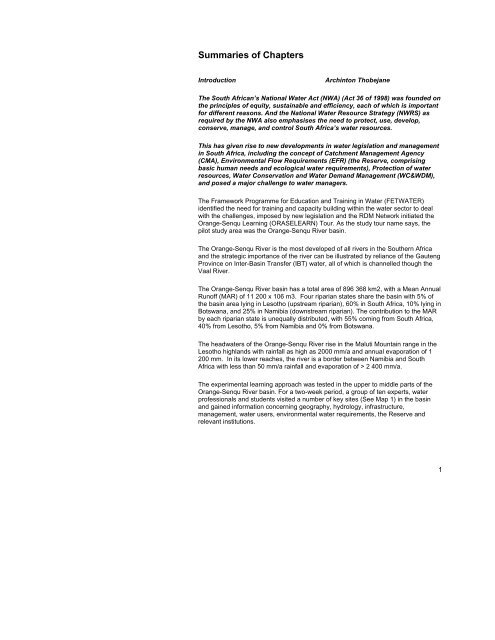An integrated assessment of socio-economic and ... - Unesco
An integrated assessment of socio-economic and ... - Unesco
An integrated assessment of socio-economic and ... - Unesco
You also want an ePaper? Increase the reach of your titles
YUMPU automatically turns print PDFs into web optimized ePapers that Google loves.
Summaries <strong>of</strong> Chapters<br />
Introduction Archinton Thobejane<br />
The South African’s National Water Act (NWA) (Act 36 <strong>of</strong> 1998) was founded on<br />
the principles <strong>of</strong> equity, sustainable <strong>and</strong> efficiency, each <strong>of</strong> which is important<br />
for different reasons. <strong>An</strong>d the National Water Resource Strategy (NWRS) as<br />
required by the NWA also emphasises the need to protect, use, develop,<br />
conserve, manage, <strong>and</strong> control South Africa’s water resources.<br />
This has given rise to new developments in water legislation <strong>and</strong> management<br />
in South Africa, including the concept <strong>of</strong> Catchment Management Agency<br />
(CMA), Environmental Flow Requirements (EFR) (the Reserve, comprising<br />
basic human needs <strong>and</strong> ecological water requirements), Protection <strong>of</strong> water<br />
resources, Water Conservation <strong>and</strong> Water Dem<strong>and</strong> Management (WC&WDM),<br />
<strong>and</strong> posed a major challenge to water managers.<br />
The Framework Programme for Education <strong>and</strong> Training in Water (FETWATER)<br />
identified the need for training <strong>and</strong> capacity building within the water sector to deal<br />
with the challenges, imposed by new legislation <strong>and</strong> the RDM Network initiated the<br />
Orange-Senqu Learning (ORASELEARN) Tour. As the study tour name says, the<br />
pilot study area was the Orange-Senqu River basin.<br />
The Orange-Senqu River is the most developed <strong>of</strong> all rivers in the Southern Africa<br />
<strong>and</strong> the strategic importance <strong>of</strong> the river can be illustrated by reliance <strong>of</strong> the Gauteng<br />
Province on Inter-Basin Transfer (IBT) water, all <strong>of</strong> which is channelled though the<br />
Vaal River.<br />
The Orange-Senqu River basin has a total area <strong>of</strong> 896 368 km2, with a Mean <strong>An</strong>nual<br />
Run<strong>of</strong>f (MAR) <strong>of</strong> 11 200 x 106 m3. Four riparian states share the basin with 5% <strong>of</strong><br />
the basin area lying in Lesotho (upstream riparian), 60% in South Africa, 10% lying in<br />
Botswana, <strong>and</strong> 25% in Namibia (downstream riparian). The contribution to the MAR<br />
by each riparian state is unequally distributed, with 55% coming from South Africa,<br />
40% from Lesotho, 5% from Namibia <strong>and</strong> 0% from Botswana.<br />
The headwaters <strong>of</strong> the Orange-Senqu River rise in the Maluti Mountain range in the<br />
Lesotho highl<strong>and</strong>s with rainfall as high as 2000 mm/a <strong>and</strong> annual evaporation <strong>of</strong> 1<br />
200 mm. In its lower reaches, the river is a border between Namibia <strong>and</strong> South<br />
Africa with less than 50 mm/a rainfall <strong>and</strong> evaporation <strong>of</strong> > 2 400 mm/a.<br />
The experimental learning approach was tested in the upper to middle parts <strong>of</strong> the<br />
Orange-Senqu River basin. For a two-week period, a group <strong>of</strong> ten experts, water<br />
pr<strong>of</strong>essionals <strong>and</strong> students visited a number <strong>of</strong> key sites (See Map 1) in the basin<br />
<strong>and</strong> gained information concerning geography, hydrology, infrastructure,<br />
management, water users, environmental water requirements, the Reserve <strong>and</strong><br />
relevant institutions.<br />
1
















